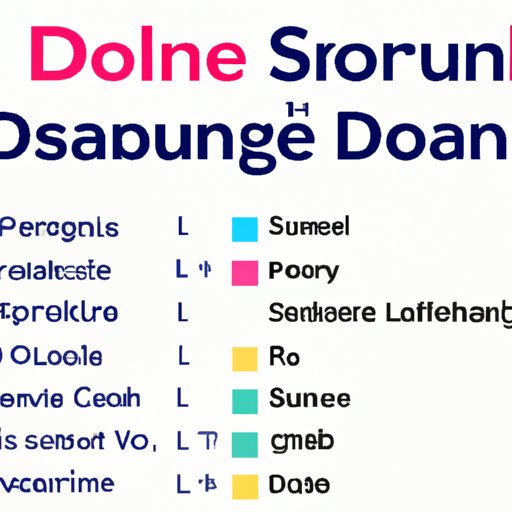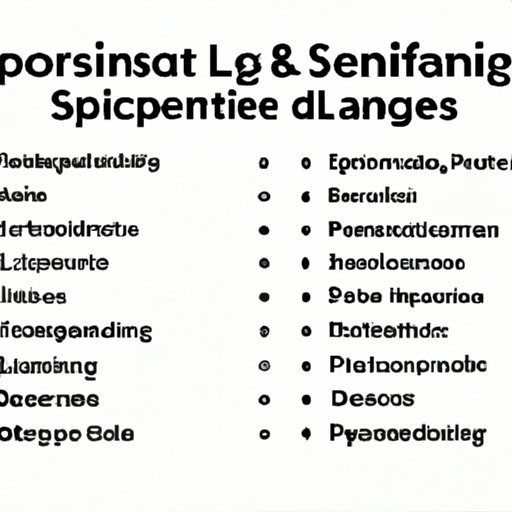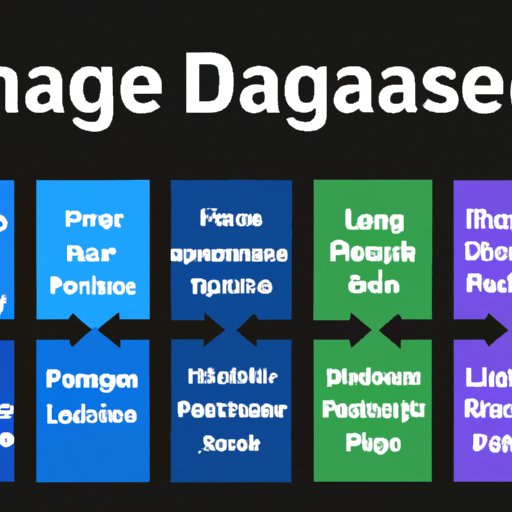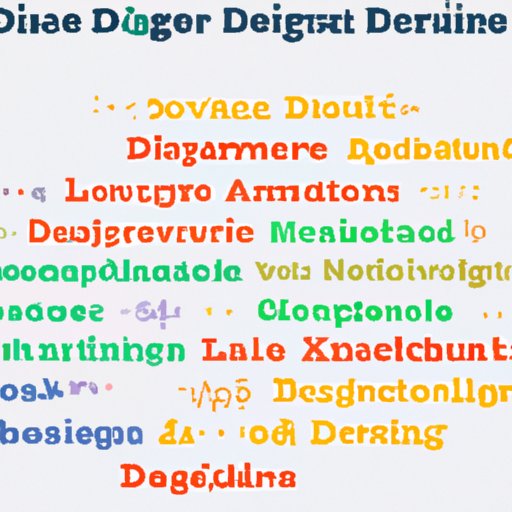Introduction
Data science is an interdisciplinary field that combines mathematics, statistics, computer science, and other fields to extract knowledge and insights from large volumes of data. As such, it requires the use of various programming languages to develop applications. Choosing the right programming language for data science can be difficult, as there are many different options available. In this article, we will explore the most popular programming languages for data science and provide an overview of their benefits and limitations.

Survey of Popular Programming Languages for Data Science
When it comes to data science, there are several programming languages that are commonly used. Let’s take a look at four of the most popular: Python, R, Java, and Julia.
Python
Python is a high-level, object-oriented programming language that is widely used in data science applications. It has a simple syntax and is easy to learn, making it one of the most popular programming languages for beginners. Python also offers a wide range of libraries for data processing, analysis, and visualization, such as NumPy, SciPy, and matplotlib.
R
R is a statistical programming language that is specifically designed for data analysis. It has a large number of libraries and packages for statistical analysis and machine learning, making it a great choice for data science projects. R is also open source, meaning it is free to use and modify.
Java
Java is a general-purpose programming language that is widely used in enterprise applications. It is known for its scalability, performance, and reliability, making it a great choice for large-scale data science projects. Java also has a wide range of libraries for data processing and analysis, such as Apache Spark and Hadoop.
Julia
Julia is a relatively new programming language that was designed for scientific computing. It combines the speed of compiled languages with the flexibility of dynamic languages, making it a great choice for data science applications. Julia also offers a wide range of libraries for data processing, analysis, and visualization.

Comparing the Benefits and Limitations of Different Programming Languages for Data Science
Now that we have an overview of the most popular programming languages for data science, let’s compare their benefits and limitations.
Pros and Cons of Each Language
Python is a great choice for beginners due to its simple syntax and wide range of libraries. However, Python is not as fast as other languages, such as Java or C++. R is specifically designed for statistical analysis, but it can be slow and difficult to learn. Java is fast and reliable, but it can be difficult to debug. Julia is fast and flexible, but it is still relatively new and may not be well supported by some libraries.
Scalability
The scalability of a programming language is important for data science projects, as they often require large amounts of data to be processed. Python and R are both highly scalable, as they can easily handle large datasets. Java is also highly scalable, as it supports distributed computing. Julia is less scalable than the other languages, as it is still relatively new and may not be able to handle large datasets.
Ease of Use
The ease of use of a programming language is important for data science projects, as they often require complex algorithms and data structures. Python and R are both easy to learn, making them great choices for beginners. Java is more difficult to learn due to its complex syntax, but it is still relatively easy to use for experienced programmers. Julia is also relatively easy to learn, but it may take some time to get used to its syntax.
Performance
The performance of a programming language is important for data science projects, as they often require complex algorithms and data structures. Python and R are both slower than other languages, such as Java and C++. Java is faster than Python and R, but it can be difficult to debug. Julia is also fast, but it is still relatively new and may not be as well supported by some libraries.
Availability of Libraries and Support
The availability of libraries and support is important for data science projects, as they often require specific algorithms and data structures. Python and R both have a wide range of libraries and support, making them great choices for data science projects. Java also has a wide range of libraries and support, but it can be difficult to debug. Julia is still relatively new and may not be as well supported by some libraries.
Overview of the Best Programming Languages for Data Science Projects
Now that we have compared the benefits and limitations of the most popular programming languages for data science, let’s take a look at the best programming languages for data science projects.
Python
Python is a great choice for data science projects due to its simple syntax and wide range of libraries. It is also highly scalable, making it a great choice for large-scale projects. Python is also open source, meaning it is free to use and modify.
R
R is specifically designed for statistical analysis, making it a great choice for data science projects. It is also open source, meaning it is free to use and modify. R is also highly scalable, making it a great choice for large-scale projects.
Java
Java is a great choice for data science projects due to its scalability, performance, and reliability. It is also highly scalable, making it a great choice for large-scale projects. Java is also open source, meaning it is free to use and modify.
Julia
Julia is a great choice for data science projects due to its speed and flexibility. It is also open source, meaning it is free to use and modify. Julia is less scalable than the other languages, but it is still a great choice for smaller projects.

Guide to Choosing a Programming Language for Data Science Applications
Choosing the right programming language for data science projects can be challenging. Here are some tips to help you make the right choice.
Considerations for Choosing a Language
When choosing a programming language for data science, consider the type of project you are working on, your skillset, the time and budget available, and the libraries and support available. For example, if you are working on a small-scale project with limited time and budget, Python may be a better choice than Java.
Types of Projects
Different types of data science projects require different programming languages. For example, if you are working on a statistical analysis project, R may be a better choice than Java. If you are working on a project that requires complex algorithms and data structures, Java may be a better choice than Python.
Skillset
Your skillset is another important factor to consider when choosing a programming language for data science. For example, if you are an experienced programmer, Java may be a better choice than Python. If you are a beginner, Python may be a better choice than Java.
Time and Budget
The time and budget available are also important considerations when choosing a programming language for data science. For example, if you have a limited budget and need to get a project up and running quickly, Python may be a better choice than Java. If you have a larger budget and more time to complete the project, Java may be a better choice.

Exploring the Most Commonly Used Programming Languages for Data Science
Now that we have explored the benefits and limitations of each programming language, let’s take a closer look at the most commonly used languages for data science.
Python
Python is a great choice for data science projects due to its simple syntax and wide range of libraries. It is also open source and highly scalable, making it a great choice for large-scale projects. Python is also easy to learn, making it a great choice for beginners.
R
R is a great choice for data science projects due to its statistical capabilities and wide range of libraries. It is also open source and highly scalable, making it a great choice for large-scale projects. R is also relatively easy to learn, making it a great choice for beginners.
Java
Java is a great choice for data science projects due to its scalability, performance, and reliability. It is also open source and highly scalable, making it a great choice for large-scale projects. Java is more difficult to learn than other languages, but it is still relatively easy to use for experienced programmers.
Julia
Julia is a great choice for data science projects due to its speed and flexibility. It is also open source and relatively easy to learn, making it a great choice for beginners. Julia is less scalable than the other languages, but it is still a great choice for smaller projects.
Pros and Cons of the Top Programming Languages for Data Science
Let’s take a look at the pros and cons of the top programming languages for data science.
Python
Pros: Simple syntax, wide range of libraries, open source, highly scalable.
Cons: Not as fast as other languages, can be difficult to debug.
R
Pros: Specifically designed for statistical analysis, wide range of libraries, open source, highly scalable.
Cons: Can be slow, difficult to learn.
Java
Pros: Fast, reliable, wide range of libraries, open source, highly scalable.
Cons: Difficult to debug, more difficult to learn than other languages.
Julia
Pros: Fast, flexible, open source, relatively easy to learn.
Cons: Less scalable than the other languages, not as well supported by some libraries.
Evaluating the Ease of Use and Capabilities of Different Programming Languages for Data Science
Now that we have explored the pros and cons of the top programming languages for data science, let’s evaluate their ease of use and capabilities.
Python
Python is a great choice for data science projects due to its simple syntax and wide range of libraries. It is also open source and highly scalable, making it a great choice for large-scale projects. Python is also easy to learn, making it a great choice for beginners.
R
R is a great choice for data science projects due to its statistical capabilities and wide range of libraries. It is also open source and highly scalable, making it a great choice for large-scale projects. R is also relatively easy to learn, making it a great choice for beginners.
Java
Java is a great choice for data science projects due to its scalability, performance, and reliability. It is also open source and highly scalable, making it a great choice for large-scale projects. Java is more difficult to learn than other languages, but it is still relatively easy to use for experienced programmers.
Julia
Julia is a great choice for data science projects due to its speed and flexibility. It is also open source and relatively easy to learn, making it a great choice for beginners. Julia is less scalable than the other languages, but it is still a great choice for smaller projects.
Conclusion
In conclusion, choosing the right programming language for data science projects can be challenging. There are many different options available, each with their own benefits and limitations. Python, R, Java, and Julia are all popular choices for data science projects, and each has its own advantages and disadvantages. Ultimately, it is up to the user to decide which language is best for their needs. Resources such as online tutorials, books, and forums can be helpful in making an informed decision.
(Note: Is this article not meeting your expectations? Do you have knowledge or insights to share? Unlock new opportunities and expand your reach by joining our authors team. Click Registration to join us and share your expertise with our readers.)
